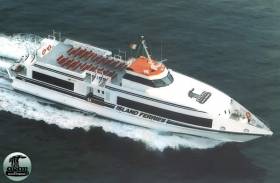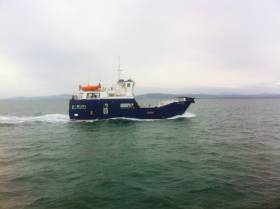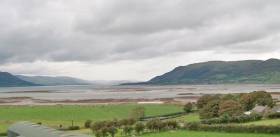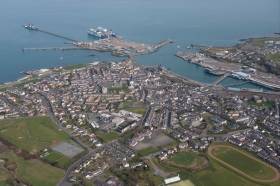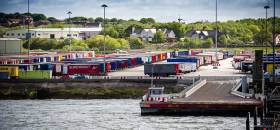Displaying items by tag: Ferry news
Naval Service Examined As Possible Short Term Solution of Ferry Crisis to Largest of Aran Islands
#AranIslands - The use of the Irish Naval Service to provide a short-term service to residents on Inis Mór (largest of the Oileán Árann /Aran Islands) is being explored by Gaeltacht Minister Sean Kyne.
As Galway Bay FM reports the proposal follows the planned withdrawal of the winter service to the largest Aran Island until March 2017, with the last ferry set to depart at 6pm this evening (yesterday, 30th November).
Operator Island Ferries Teoranta has reaffirmed it’s intention to suspend the service – citing the ‘negative fiscal conditions’ created by the local authority with the introduction of passenger levies.
For more on the developing story, click here.
Afloat.ie adds that vital sea transportation links to Inis Mór are still been maintained albeit by a cargo-only operator, Lasta Mara Teoranta. This company serves the three islands from the mainland not just out of Rossaveel in Connemara but also Galway Port.
As of this morning Afloat.ie monitored their coastal freighter MV Bláth na Mara that departed Inis Oirr bound for Galway Port's outer pier. This is the final leg of a round trip that previously included calls firstly to Inis Mór followed by Inis Meáin.
Another crises that faced islanders was in August when Lasta Mara's other freight ro-ro vessel MV Chateau-Thierry came to the aid of two of three islands with generators that were used to restore electricity. This followed power-cuts caused by a damaged subsea cable connecting the mainland.
Leinster Seaboard Trials Continue for Arklow Newbuild Northern Car Ferry
#SeaTrials – Off the Leinster seaboard an Arklow built car ferry contracted by Northern Ireland’s Department of Infrastructure continues to carry out sea trials today, writes Jehan Ashmore.
As previously reported on Afloat.ie the Spirit of Rathlin, a 6 vehicle /140 passenger capacity ferry was launched in September by Arklow Marine Services for the Ballycastle-Rathlin Island route.
The twin-screw car ferry with Belfast as a port of registry departed Arklow from where this morning the 28m long vessel with a beam of 8m is currently underway on sea trials.
Earlier this month the identity of the new operator of the Co. Antrim service to use Spirit of Rathlin following a procurement process was according to Dfi to be announced shortly.
It is rare to have an Irish built car-ferry as previously reported when the newbuild was hoisted from the North Quay in Arklow to be lowered into the River Avoca. The yard owned by the famous Tyrrell family whose generations have built small ships and boats at the shipyard stretching to 1864.
The yards founder John Tyrell opened the boatbuilding facility then on the south quays of the river. In more recent years one of the yard's most iconic vessels built was the brigantine Asgard II. This two-masted tallship was the Irish state’s first custom built sail training vessel launched in 1984.
In terms of car ferry construction the yard for example built in 1999 the Ikom K a 4 car / 60 passenger capacity ferry and likewise of Spirit of Rathin ordered for domestic service. The Ikom K though operates for clients in southern waters for owners Murphy Ferry Service linking Castetownbere to Bere Island, Co. Cork.
Storm Sees Stranded Stena Line Ferry At Sea
#StrandedFerry - A Stena Line ferry reports RTE News will make another attempt to dock at the Port of Fishguard, Wales at around midday today - weather permitting.
The ferry, with 87 passengers and 59 crew on board, departed Rosslare yesterday at 9am but failed to dock twice due to high winds and rough seas.
A spokeswoman for Stena Line said: "The health and safety of passengers and crew is of paramount importance to Stena Line, therefore the 87 passengers and 59 crew members will remain onboard overnight until a second attempt at docking takes place at midday tomorrow."
Services on the Dublin to Holyhead crossing are expected to run as normal today, but intending passengers are advised to check in advance.
Yesterday, the UK was lashed by heavy rain as Storm Angus caused flooding and travel chaos across many parts of the country. For more on this click here
Legal Challenge To Carlingford Ferry Rejected
#FerryNews - A legal challenge against a new car ferry route across Carlingford Lough has been rejected, according to the News Letter.
The route across the narrowest part of the lough between Greencastle in Co Down and Greenore in Co Louth was given the go-ahead in the summer of 2015 against the objections of some local residents – some of whom took their case to Belfast High Court requesting a judicial review against Newry, Mourne and Down District Council.
However, a case by one litigant was this week dismissed by Justice Adrian Colton, who said: “There is simply no expert evidence which begins to challenge the conclusions of the various environmental impact assessments which were carried out throughout the entire process.”
The complainant, who lodged her appeal in May this year, had accused the council and Northern Ireland’s Department of Agriculture, Environment and Rural Affairs of a flawed consultation and assessment process ahead of work on a new ferry terminal near her home in Greencastle.
But the judge declared her argument over protections for marine wildlife in the lough was “misplaced as a matter of law” as the area is not a designated Special Area of Conservation.
The News Letter has more on the story HERE.
Operator of Irish Ferries Results Show Low Sterling Exposure
#IrishFerries - Irish Ferries a division of owners Irish Continental Group (ICG) reported a 1.6pc rise in revenues in the year so far, and said it has a low level of exposure to sterling.
As the Independent.ie writes the company behind Irish Ferries, which operates between Ireland and Britain, said in a trading update that the impact of the plunge in sterling since the Brexit vote in June had so far been offset by lower costs.
The company said it had a low level of net sterling exposure. In the 10 months to the end of October, (ICG) consolidated revenue was €280.2m, up 1.6pc from a year ago, it said.
Net debt stood at €25.6m at the end of the period, compared to €44.3m at the end of 2015. Construction of a new cruise ferry announced on May 31 remains on schedule for delivery in May 2018, the company said.
For more detailed financial trading figures released by ICG click here
Afloat adds that their ropax ferry MV Kaitaki (formerly Isle of Inishfree) remained on charter, operating in New Zealand, while four container ships (see EUCON trading results report) acquired in late 2015 were fully deployed in the period.
Also previously covered on Afloat, the charterer of the HSC Westpac Express exercised their option to extend the charter for a further period of up to 12 months to October 2017. The charter is subject to usual US government procurement regulations and the charterer has further options to extend the charter up to mid 2021.
The construction of a new 50,000 gross tonnage cruise ferry costing €144m announced in May this year remains on schedule for delivery in May 2018.
Customs Checks at Holyhead Port Will be Brought Back in After Brexit
#BrexitPorts - The Welsh First Minister has said customs checkpoints at Holyhead, the north Wales ferryport on Anglesea will have to be set up ahead of Britain leaving the EU.
The Daily Post writes that while there are currently ad hoc checks on lorries and vehicles coming through the port from Ireland and other EU countries, they are not a permanent feature. But once Brexit happens and Britain quits the European Union, there will need to be customs officials there on a permanent basis.
However, the Welsh Minister Carwyn Jones,speaking exclusively to the Daily Post, said anything further - such introducing full border controls between the UK and Ireland, would be chaos for North Wales. He said: “We are going to see customs back in Holyhead anyway ... but if you had passport control in Holyhead then you are going to see queues all across the island.”
For more click here and including previous coverage of the implications facing Stena Line (which sail to Dublin Port) which they say Brexit will have a 'completely new situation'.
Shipping Snapshot: Cork Harbour's Diverse Range of Vessels
#PortSnapshot - Shipping movements in the Port of Cork have included in recent days a diverse range of vessels that are based and have visited the natural harbour, writes Jehan Ashmore.
Outlined below are vessels that Afloat.ie have tracked and their respective business activity.
Kinsale GasField Supply Support Ship: Ocean Spey a supply tug support vessel, newly introduced at the Kinsale Energy Ltd facility (formerly Marathon Oil) is currently operating offshore. The 66m vessel is reported to be registered in Ireland and is serving the pair of gas rig platforms located approximately 50kms off the south coast of Cork. Afloat will have more to report on Ocean Spey.
The vessel which also has anchor handling capabilities was built in 2000 and has a 1,864 gross tonnage. Meanwhile the main Kinsale Gasfield standby support ship, Pearl, operated by Cork based Mainport Group, (owners subsidiary Seahorse), is currently at the lay-by berth at Cork Dockyard, Rushbrooke near Cobh.
Brittany Ferries Flagship Service: Pont-Aven, Brittany Ferries flagship of 41,700 gross tonnage made her final Cork-Roscoff end of season sailing on Saturday.
In advance of the season the cruiseferry was fitted with 'scrubbers' to reduce harmful sulphur emissions (the only ferry in Irish waters with this 'green' technology as previously explained here).
The Ireland-France route began in 1978, the same year gas was first produced from the Kinsale Head area in the Celtic Sea. The 2,400 passenger/650 car ferry is to resume service in April, 2017.
Dutch Naval Submarine: A more unusual sight to Cork Harbour has been submarine HNLMS Bruinvis of the Royal Netherlands Navy (NATO member). The non-nuclear powered 68m submarine built during the Cold War is equipped with almost 40 torpedoes missiles.
The crew having paid a visit to Cork City for a long weekend departed yesterday using its diesel electric engines.
Newbuild Ferries for Northern Ireland Services Undergo Trials
#NewBuilds – A pair of newbuild ferries for Northern Ireland waters, one destined for an island route, the other an estuary link, are both undergoing trails prior to entering service, writes Jehan Ashmore.
A month ago today, Strangford 2 arrived onto Strangford Lough. The new car-ferry is to serve the estuary crossing linking Strangford and Portaferry. The towns are separated by strong tidal waters known as the ‘Narrows’.
Responding to Afloat.ie, the Department for Infrastructure (DfI) said “the Strangford 2 is currently being used for crew training and familiarisation which will continue for several weeks.”
Strangford 2 has a 28 vehicle/260 passenger capacity and was built by Cammell Laird, Birkenhead on Merseyside. As previously reported, the newbuild is to enter service this autumn, joining the 2001 built Portaferry 2.
The second newbuild, Spirit of Rathlin with a 6 vehicle /140 passenger configuration was built by Arklow Marine Services for the Ballycastle-Rathlin Island route. AMS having built Rathlin Express which is operated by the Rathlin Island Ferry Ltd.
As to the operator of the new Co. Antrim car-ferry, the Dfi commented, “the Department is finalising the procurement process and will hope to announce a preferred bidder shortly.”
In late September Spirit of Rathlin was launched into the River Avoca having been lowered by floating heavy-lift crane, Lara 1 which had sailed from Liverpool.
Afloat has tracked the estuary-bound car-ferry which in recent days was on sea-trials out as far as the Arklow Bank off the Co .Wicklow coast.
Heysham Port's New Road Link Opens With Plans for Further Development
#PortLinks - Irish Sea and Isle of Man ro-ro operators using Heysham Port, in north-west England, now have a new link road, the Bay Gateway connecting the M6, bypassing congestion in Lancaster, writes Jehan Ashmore.
The Bay Gateway opened on Monday and the new road infrastructure will directly benefit the Lancashire port’s main cross Irish Sea clients, Seatruck Ferries and Stena Line. The Irish Sea's only dedicated unaccompanied freight trailer operator, Seatruck operates to ports in the Irish Republic and Northern Ireland. Stena's freight-only Heysham service concentrates solely to Belfast Port.
Also to benefit the Isle of Man Steam Packet Company whose main year-round route serves Douglas, where seasonal-routes fast-ferry, Manannan will for a second winter lay-up at the Manx capital until at least the end of this year.
In another development at Heysham (Peel Ports Group) has announced they are to invest in a new £10m link-span bridge and fourth berth. This is to accommodate larger ro-ro vessels.
The funding will also see a new pontoon built to support offshore crew transfer vessels, a new port entrance created and various improvements to the port IT and terminal operating systems. Work on the project to expand capacity begins this month and is scheduled to be completed in October 2017.
Port director, David Huck said: “This is a transformational time for Heysham port. Our major investment to increase capacity and flexibility will further strengthen the port’s role as a logistics hub for the region, particularly for services to Ireland and the Isle of Man. We’ve also built in an element of future-proofing, giving us the ability to accommodate projected volumes for many years to come.”
Heysham Port is also the closest to several major offshore infrastructure projects, the proposed National Grid connection of Moorside nuclear power station in Cumbria and the Dong Energy Walney Extension wind-farm.
UK Ports Operator Offers Funding If Arran Ferry Switches Scottish Port
#PortRelocation? - A large UK ports operator proposes to donate community funding to the Isle of Arran, if the island’s lifeline ferry service on the Firth of Clyde relocates to one of its owned ports, writes Jehan Ashmore.
The ports company, Associated British Ports (ABP) plans to create an Arran Community Fund, which will generate £50,000 a year, or around £1,000 a week, to benefit the island community. As part of an original deal (see below), the ferry port on the mainland at Ardrossan that serves Brodick (Arran) operated by Caledonian MacBrayne (CalMac) would transfer to neighbouring Troon.
As previously reported by Afloat.ie, Troon was last in use by P&O Ferries to Larne, until seasonal fast-ferry services closed in 2015, leaving an existing Larne-Cairnryan service on the North Channel to compete with Stena Line's Belfast-Cairnryan alternative.
It is claimed by ABP that the current ferryport, Ardrossan, also on the Ayrshire coast, is dogged by weather conditions that frequently exceed the capabilities of the port and result in a significant level of service cancellations. Approximately 150 crossings were cancelled last year, causing major issues for the travelling public and tourists trying to visit the island, dubbed ‘Scotland in miniature’.
The Ardrossan-Brodick route is served by Caledonian Isles and additional capacity in summer by Isle of Arran that also operates a seasonal-route out of Ardrossan to Campbeltown, Mull of Kintyre. This summer was the route’s first season as a ‘permanent’ service after a three year pilot programme.
ABP has already announced plans to invest £8 million in Troon, where the state-of-the-art passenger ferry terminal would serve the Isle of Arran. In contrast to Ardrossan, comparable journey times using Troon’s sheltered harbour offers the prospect of a reliable service for islanders, largely unaffected by adverse weather conditions.
Troon also offers improved road and increased rail connections, with access to the upgraded A77/M77 motorway and four trains per hour to Glasgow.
Afloat this summer featured the route from Ardrossan to the island’s ferryport at Brodick, to include coverage of the redevelopment work at the terminal on Arran by operator, CalMac.
The public funded ferry company which serves the Hebrides & Clyde Isles extensively, won the EU tender ferry bid from Transport Scotland in a £900m contract for the next eight years which began at the start of this month. It should be noted ABP Ports port relocation formed part of its application among those submitted for the Western Isles ferry contract.
The next generation of a pair of larger ferries for CalMac under construction on the Clyde, in which as least one vessel is destined for the Arran route. According to ABP, these newbuilds will too be able to use Troon’s existing 160-metre berth, which is well equipped to handle the 1,000 passenger/ 127 cars/16 HGV's (or combination) ferry sisters.


























